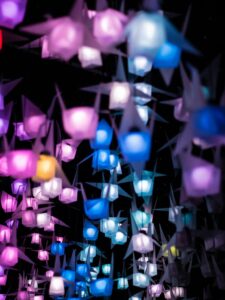 Asian art has had a profound impact on modern paper crafting, influencing techniques, trends, and traditions in ways that are both subtle and overt. This influence is evident in the meticulous craftsmanship, intricate designs, and the philosophical underpinnings that characterize contemporary paper art. Historically, paper crafting has deep roots in Asian cultures, particularly in countries like China, Japan, and Korea, each of which has contributed unique elements that continue to shape modern practices.
Asian art has had a profound impact on modern paper crafting, influencing techniques, trends, and traditions in ways that are both subtle and overt. This influence is evident in the meticulous craftsmanship, intricate designs, and the philosophical underpinnings that characterize contemporary paper art. Historically, paper crafting has deep roots in Asian cultures, particularly in countries like China, Japan, and Korea, each of which has contributed unique elements that continue to shape modern practices.
To begin with, one cannot discuss the influence of Asian art on paper crafting without acknowledging the invention of paper itself in China around 105 AD by Cai Lun. This groundbreaking development laid the foundation for various forms of paper artistry, such as origami (more info at origami-shop.com), kirigami, and paper cutting. These traditional Asian techniques have been adapted and refined over centuries, merging with Western styles to create a rich, hybrid form of art. For example, origami, the Japanese art of paper folding, has transcended its cultural origins to become a global phenomenon. Modern paper crafters often incorporate origami techniques into their work, creating pieces that are both aesthetically pleasing and structurally complex.
Moreover, the philosophical aspects of Asian art have also permeated modern paper crafting. In many Asian cultures, art is not merely a form of expression but a meditative practice that fosters mindfulness and patience. This is particularly evident in the Japanese concept of “Wabi-Sabi,” which finds beauty in imperfection and impermanence. Many contemporary paper artists embrace this philosophy, allowing the natural texture and irregularities of paper to enhance the overall aesthetic of their work. This approach stands in stark contrast to the Western emphasis on precision and perfection, thereby offering a fresh perspective on artistic creation.
In addition to philosophical influences, specific Asian artistic techniques have been integrated into modern paper crafting. For instance, the Chinese art of paper cutting, known as “Jianzhi,” involves creating intricate patterns and designs by cutting paper with scissors or knives. This technique has inspired modern crafters to experiment with negative space and intricate detailing in their projects. Similarly, “Kirie,” the Japanese equivalent of paper cutting, has found a place in contemporary art galleries around the world, showcasing the timeless appeal of this ancient technique.
Furthermore, the materials used in Asian paper art have also made their way into modern crafting. Traditional papers like “Washi” from Japan and “Xuan” paper from China are highly prized for their durability, texture, and ability to hold ink and dyes. These papers are often used in high-end paper crafting projects, adding an element of authenticity and quality that is hard to replicate with mass-produced paper.
The influence of Asian art on modern paper crafting is also evident in contemporary trends. Many paper artists are now exploring mixed media approaches, combining traditional paper techniques with modern technologies like laser cutting and digital printing. This fusion of old and new allows for greater creative freedom and innovation, pushing the boundaries of what is possible in paper art.
In conclusion, the influence of Asian art on modern paper crafting is multifaceted, encompassing historical techniques, philosophical approaches, and material choices. This rich tapestry of influences has not only preserved ancient traditions but also fostered new forms of artistic expression. As modern paper crafters continue to draw inspiration from Asian art, the boundaries of this versatile medium will undoubtedly continue to expand, creating a dynamic interplay between past and present, tradition and innovation.
